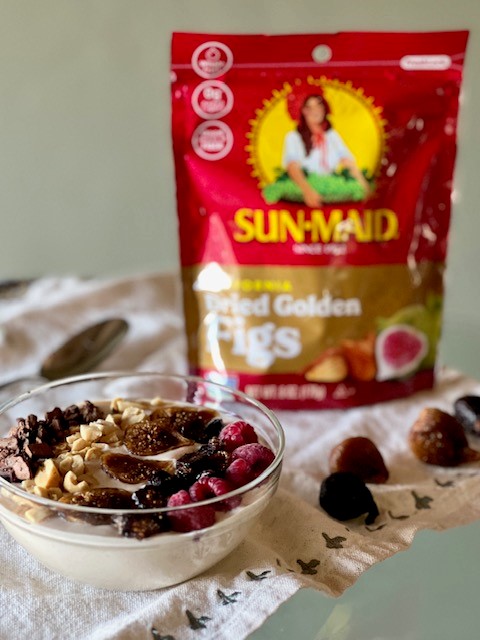Jump on the Cottage Cheese Revival: Peanut Butter Mousse and Whipped Feta Cream

Protein-packed cottage cheese is having a moment (1) and blitzing it into something irresistibly creamy is the move. It was top-of-mind for recipes featuring California dried figs when the Valley Fig Growers asked me to write a website article on health research using a fig extract (2,3).
Chewy dried figs are the perfect topper to a creamy Peanut Butter Cottage Cheese Mousse which you can savor as a breakfast, lunch, or snack. For a savory spin, whirl cottage cheese with feta and olive oil for a spread (shown on a grainy cracker with figs and herbs) or dip.

What is the scoop on fig extract? Figs are one of the richest sources of abscisic acid which has been shown to help control blood sugars. Almost everyone knows someone struggling with elevated blood sugar levels or full-blown diabetes who might benefit from a well-tolerated, naturally derived substance that helps manage blood glucose levels.
Worldwide, diabetes has reached epidemic proportions and is associated with serious and costly complications. In the U.S.A. over 11% of Americans have diabetes and 90 to 95% have type II diabetes. Another 38% of Americans have prediabetes which can evolve into type II diabetes if not treated. With treatment, prediabetes can be reversed (4).
Like insulin, abscisic acid helps cells take up glucose, and does other good things like control inflammation and maintain the immune system. Earlier research with abscisic acid were in vitro or with animal models. This study used 10 healthy human subjects, given the abscisic acid rich fig extract with a glucose drink. The study showed that adding the fig fruit extract to the glucose beverage significantly reduced glycemic and insulin responses compared to a glucose drink alone (3,5,6).
A special property of abscisic acid it that it helps manage blood sugar levels without causing the pancreas to keep making insulin. In other words, it may prevent the over-stimulation of the pancreas beta cells that occurs in insulin resistance that can eventually wear them out and cause them to stop making insulin.
Where does abscisic acid come from? It is a phytohormone that helps plants survive under stress, so we get it in our diet by eating fruits and veggies. Sadly, 88 to 90% of people don’t meet recommendations for vegetable and fruit consumption so average intakes of abscisic acid are very low. The human body make it too, although studies show the metabolism of abscisic acid is impaired in people with type II diabetes and gestational diabetes (5).
Additional research needs to be done with more people and people with impaired glucose metabolism to confirm these interesting, potential benefits of abscisic acid. In the meantime, grab your blender and get buzzing with the cottage cheese revival.

Peanut Butter Mousse
Blend 2 cups (1 lb) cottage cheese (probiotic-rich versions are popular) with 3 tablespoons peanut butter (or other nut butter) and 3 tablespoons maple syrup with a splash of vanilla extract. Chill. Shower with chopped peanuts and your favorite toppings. Serves 4, each with about 17 grams of protein.
Feta Cottage Cheese Cream
Whirl 2 cups (1 lb.) cottage cheese (whole milk or 2%), 1 cup top-quality crumbled feta cheese, 1-2 tablespoons extra virgin olive oil and ½ to 1 teaspoon lemon zest into a creamy spread or dip.
What is Cottage Cheese? Thought to be the first cheese made in the U.S.A., cottage cheese is a fresh, unaged cheese similar to European fresh farmhouse cheeses made with naturally soured milk. The curds are separated from the whey which reduces the calcium content, but it remains rich in protein and a good source of riboflavin (7).
References
- Whey Cool: Gen Z Discovers Cottage Cheese – WSJ
- Fig Extract Benefits: a Future for Figs? (valleyfig.com)
- Abscisic Acid Standardized Fig (Ficus carica) Extracts Ameliorate Postprandial Glycemic and Insulinemic Responses in Healthy Adults – PMC (nih.gov)
- The Facts, Stats, and Impacts of Diabetes | CDC
- Frontiers | Abscisic Acid: A Novel Nutraceutical for Glycemic Control (frontiersin.org)
- Chronic Intake of Micrograms of Abscisic Acid Improves Glycemia and Lipidemia in a Human Study and in High-Glucose Fed Mice – PMC (nih.gov)
- Cottage Cheese | The California Dairy Press Room & Resources
© Lorelle Del Matto 2023
 About lorelle
About lorelle
You make appetizers approachable ,healthy and fun !
Thanks Lorelle
Thank you!